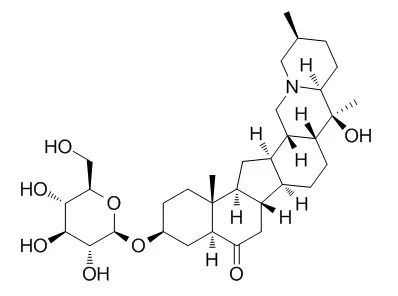| In vitro: |
| Chemistry of Natural Compounds, 2003 , 39 (6) :603-4. | | Accumulation Dynamics of Alkaloids in Petilium eduardi[Reference: WebLink] |
METHODS AND RESULTS:
In continuation of studies of alkaloids from P. eduardi Rgl. [3, 4], we investigated the accumulation dynamics of alkaloids from plants collected in the South Pamir-Alai mountains on slopes of Gissarsk ridge near Shargun, Zivar, in Khanaka and Babatag. Samples of the air-dried raw material were treated with ammonia (10%). Alkaloids were extracted with CHCl 3 in a Soxhlet apparatus. After the extraction was complete, the extract was decanted, concentrated to a small volume, and extracted with H 2 SO 4 (5%). The acidic solution of bases was washed with ether and made basic with ammonia (25%). Alkaloids from the basic solution were extracted with CHCl 3. The total alkaloids were treated with acetone to isolate imperialine and a glycoalkaloid of imperialine, Edpetiline (CH 3 OH) [5-7]. Imperialine and Edpetiline are the principal alkaloids from P. eduardi. Table 1 shows that the bulbs in the early period of vegetation contain the maximum total alkaloids. The maximum content of the main alkaloid, imperialine, occurs in the aerial part during the start of flowering. The second principal alkal oid, Edpetiline, is observed in relatively small amounts compared with imperialine, from 1.2 to 6.7% of the total alkaloids. Their content is lowest during fruiting and flowering of the aerial part of plants collected in Khanaka and the Botanical Garden. We were unable to isolate pure alkaloids from the specimen introduced into the Botanical Garden (Table 1).
CONCLUSIONS:
Thus, a comparison of the total content and pure alkaloids isolated from plants of different vegetative stages and habitats revealed the effect of soil and climate conditions on their quality and quantity. |
|






 Cell. 2018 Jan 11;172(1-2):249-261.e12. doi: 10.1016/j.cell.2017.12.019.IF=36.216(2019)
Cell. 2018 Jan 11;172(1-2):249-261.e12. doi: 10.1016/j.cell.2017.12.019.IF=36.216(2019) Cell Metab. 2020 Mar 3;31(3):534-548.e5. doi: 10.1016/j.cmet.2020.01.002.IF=22.415(2019)
Cell Metab. 2020 Mar 3;31(3):534-548.e5. doi: 10.1016/j.cmet.2020.01.002.IF=22.415(2019) Mol Cell. 2017 Nov 16;68(4):673-685.e6. doi: 10.1016/j.molcel.2017.10.022.IF=14.548(2019)
Mol Cell. 2017 Nov 16;68(4):673-685.e6. doi: 10.1016/j.molcel.2017.10.022.IF=14.548(2019)